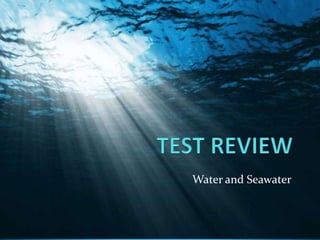Test Review: Water and Seawater
•Download as PPTX, PDF•
0 likes•82 views
Report
Share
Report
Share

Recommended
A continental assessment of global climate change

A continental assessment of global climate changeProfessor Eric K. Noji, M.D., MPH, DTMH(Lon), FRCP(UK)hon
Recommended
A continental assessment of global climate change

A continental assessment of global climate changeProfessor Eric K. Noji, M.D., MPH, DTMH(Lon), FRCP(UK)hon
Water and Seawater: Pycnocline, Thermocline, Desalination, & Light transmission

Water and Seawater: Pycnocline, Thermocline, Desalination, & Light transmissionBantay's Oceanography
More Related Content
What's hot (19)
Global Warming, Red Tide, El Nino, and Coral Bleaching

Global Warming, Red Tide, El Nino, and Coral Bleaching
Viewers also liked
Water and Seawater: Pycnocline, Thermocline, Desalination, & Light transmission

Water and Seawater: Pycnocline, Thermocline, Desalination, & Light transmissionBantay's Oceanography
Viewers also liked (19)
Water and Seawater: Pycnocline, Thermocline, Desalination, & Light transmission

Water and Seawater: Pycnocline, Thermocline, Desalination, & Light transmission
Analysis and Sediment of Savannah Scrarp and Charleston Bump

Analysis and Sediment of Savannah Scrarp and Charleston Bump
Quiz Review: Atmospheric Layers and Energy Transfer

Quiz Review: Atmospheric Layers and Energy Transfer
Similar to Test Review: Water and Seawater
Similar to Test Review: Water and Seawater (20)
Chemical and physical features of seawater and the

Chemical and physical features of seawater and the
Chemical and physical features of seawater and the

Chemical and physical features of seawater and the
Test Review: Water and Seawater
- 2. Can Polar oceans completely freeze? No
- 3. What is the density of water? 1 g/cm3
- 4. Why do you put salt on icy roads or sidewalks? It lowers the freezing point of water.
- 5. What is the percentage of freshwater readily available? Less than 1%.
- 6. What do hydrogen bonds account for? Acts as a solvent Has high surface tension High boiling point High heat capacity
- 7. Why can insects walk on water? Surface tension
- 8. The ocean is slow to heat and slow to cool. Why? High heat capacity
- 9. How is the ocean layered? Density Temperature salinity
- 10. True or False? Increasing heat is an object’s response to an increase in temperature. False. This is called “latent” heat.
- 11. Which wavelengths of light can penetrate the deepest into the ocean? Green and blue.
- 12. What determines density of seawater? Salinity and temperature
- 13. What determines a zone of the ocean’s salinity rapidly changing? pycnocline
- 14. What is the percentage of incoming sunlight absorbed by the land and water? 51%
- 15. What is the main carrier of heat between the warm tropics and cold polar regions? The atmosphere.
- 16. Is the speed on sound in water slower or faster than the speed on sound in air? faster
- 17. What is the average salinity of seawater? 34 ppt.
- 18. What are the 2 most abundant elements dissolved in seawater? Sodium Chloride
- 19. Acid – high or low value? Low
- 20. What is a solution made of? Ion atom
- 21. Water Cycle
